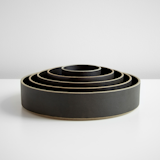Exquisite Craftsmanship Breathes New Life Into a “Socially Sustainable” Home
Incredible curved brick masonry, indigenous Wurundjeri motifs, and a Roman aqueduct-like bridge combine in the Ruckers Hill House, a unique home where unexpected surprises await at every turn.
"Our clients wanted something totally original for their home—classic, fun, quirky, and not too loud on the street," shares Mel Bright, director of Studio Bright. "Something that took advantage of the site and was sympathetic to the original Edwardian home. In particular, they wanted it to reflect them and not feel like any other house."
Fusing the studio’s interest in social sustainability with their client’s personalities, the architects crafted a home for a family of five that mimics a palimpsest respectful of the original Edwardian house on site while adding thoughtful references to the Wurundjeri people of the Eastern Kulin nation—the "traditional custodians" of the land where Studio Bright’s projects are located—as well as the Greek and Italian families who have lived in the inner-city suburb since the mid-twentieth century.
The project began with stripping back the existing Edwardian in an exhaustive restoration process that saw the removal of unsympathetic additions and the rehabilitation of original elements that had become seriously degraded over time.
With the period house reconfigured into four bedrooms with attendant bathrooms in traditional room proportions, the architects were free to place flexible living spaces into a contemporary two-story extension in the rear garden.
"Pushing the new addition to the back of this site allowed north-sun-filled living spaces, but also a streetscape expression akin to a garden pavilion, contemporary and street-tough, but a little bit Edwardian in spirit," note the architects.
Curved lines and cream-colored bricks define the contemporary extension, which houses communal spaces on the ground floor. The library, guest room, and study are on the upper floor.
"The upper level curved forms come from a desire to avoid a stepped building form – the curved form comes out to make a vertical street wall and also makes the space for 2 roof decks," explains Bright. "The curved forms gently turn the corner and allow spaces to flow and circulate easily. It’s not a hard corner and allows the form to gently shift direction."
A linear north-to-south link with arched windows connects the Edwardian to the extension. "The link space is seen more like a veranda to the garden – a colonnade space that sits between the pool and garden," explain the architects. "It spans the site bridge-like, almost an inverted Roman aqueduct with its water at the bottom. Its spatial use is unclear yet full of possibility: poolside chaise, veranda to a garden, even at times an indoor cricket pitch."
"A long linear space without specific use is an oddity, but by locating open gardens towards the street and siting the new pool behind the link, we could make a pathway space that’s all about swaying greenery and the rippling, reflected play of light," explain the architects. The link also serves as a sunroom in winter and opens up in summer.
The studio’s civic ambitions also informed the orientation and design of the addition. "The planning of this house allows for a sequence of architectural conditions and spaces that continue our interest in social sustainability and activating relationships between residences and the surrounds, with architecture that engages its context and activates site while offering something both for the inhabitants and the surrounding neighborhood," explains Bright.
A glimpse inside the bridge-link hall that connects the period house with the contemporary extension. To mark the threshold between the two structures, artist Nadine Keegan crafted a stained glass window (not pictured) that depicts imagery of the current city, fruit trees from the Greek and Italian immigrant families, and the Yam Daisies that had been grown in the area by the Wurundjeri people.
"We believe even private houses should have ambitions beyond the ‘private’ brief and that they should offer something back to the city and suburbs; from references to neighboring corrugated iron fences to street-edge planters that soften the streetscape, our ambition is to animate the local context and add to the green space of the city." Moreover, the firm has focused on partnering with a diverse group of makers and designers who are primarily local, emerging, or supportive of Indigenous people.
A bronze mesh veil fitted to the dining room window provides privacy while allowing for views of the street and the corrugated garages that inspired the exterior walls. The space is furnished with a Boyd table from KFive + Kinnarps Australia, Thonet No. 18 dining chairs, Schiavello Furniture stools as well as lights by Neri&Hu and CRITERIA.
Shop the Look
Passive solar principles and indoor/outdoor living have further shaped the home, which includes solar panels, hydronic heating, and water tanks.
"Every room of the house is imprinted with the character of the clients and their three children; rooms are configured for the specialized interests of particular family members, yet each offers scope for temporal adaptations on the fly," notes Bright.
Of her favorite feature of the home, Bright shares: "Seeing kids jumping into the pool from the upturned arches. It’s wonderful to see that a space can be not only beautiful and still, but also totally animated and lots of fun."
Related Reading: A Historic Melbourne Home Is Respectfully Modernized For a Young Family
Project Credits:
Architect of Record: Studio Bright / @studio__bright
Builder/ General Contractor: 4AD Constructions
Structural Engineer: Meyer Consulting
Landscape Design Company: tnla (consultant), MJR Landscape (installation)
Stylist: Jess Kneebone
Published
Last Updated
Get the Pro Newsletter
What’s new in the design world? Stay up to date with our essential dispatches for design professionals.



























